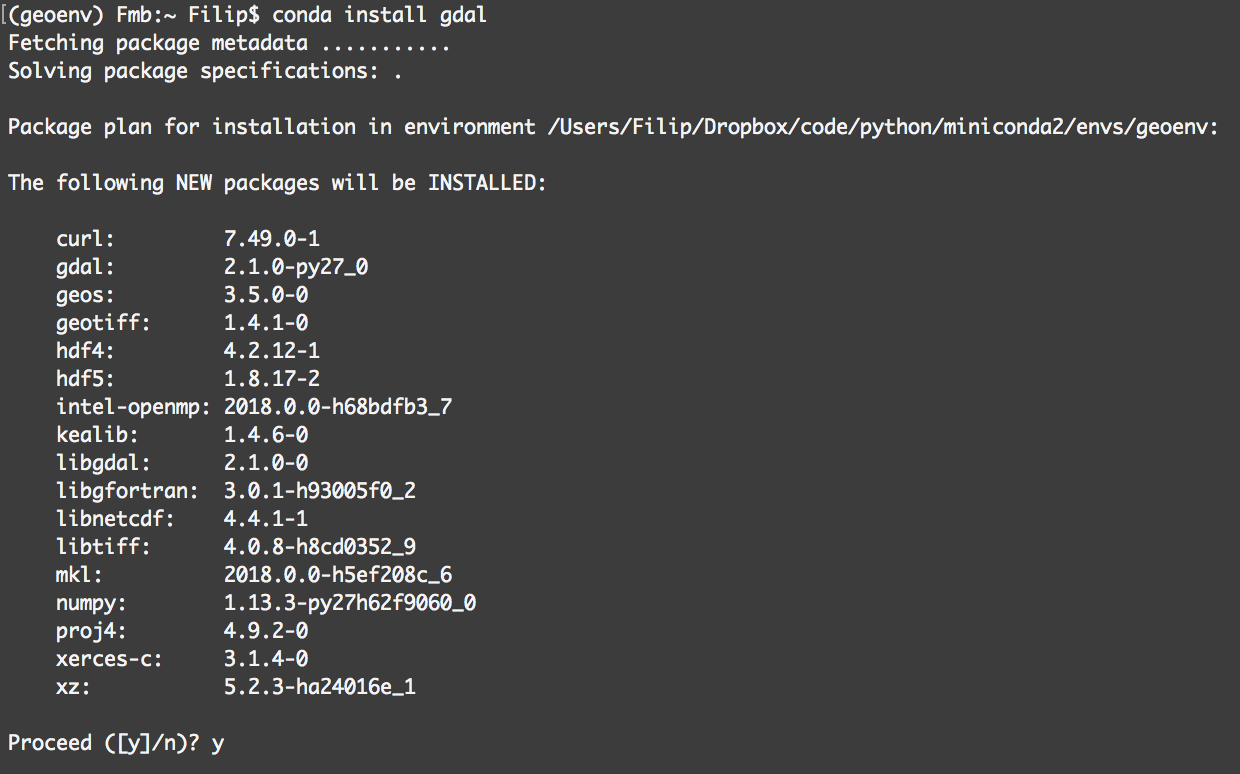
Showing posts with label BioDocker. Show all posts
Showing posts with label BioDocker. Show all posts
Sunday, 10 November 2019
10 minutes guide to Bioconda
Bioinformatics is complicated, what with its arcane command-line interface, complex workflows, and massive datasets. For new bioinformaticians, installing the software can present a problem.
 But the good news is that the Bioinformatics community has already a solution to this problem: BioConda + BioContainers.
But the good news is that the Bioinformatics community has already a solution to this problem: BioConda + BioContainers.

Etiquetas:
BioConda,
BioContainers,
BioDocker,
Bioinformatics,
Conda,
Containers,
Docker,
Large-Scale data analysis
Sunday, 13 March 2016
Genome Mapping and SNP Calling with BioDocker
#http://www.htslib.org/workflow/#mapping_to_variant set -xeu FQ1=y1.fastq FQ2=y2.fastq REF=yeast.fasta BNM=yeastD RUNINDOCKER=1 SAMTOOLS=samtools BWA=bwa TABIX=tabix BCFTOOLS=bcftools PLOTVCFSTATS=plot-vcfstats if [[ "$RUNINDOCKER" -eq "1" ]]; then echo "RUNNING IN DOCKER" DRUN="docker run --rm -v $PWD:/data --workdir /data -i" #--user=biodocker SAMTOOLS_IMAGE=biodckr/samtools BWA_IMAGE=biodckr/bwa TABIX_IMAGE=biodckrdev/htslib:1.2.1 BCFTOOLS_IMAGE=biodckr/bcftools docker pull $SAMTOOLS_IMAGE docker pull $BWA_IMAGE docker pull $TABIX_IMAGE docker pull $BCFTOOLS_IMAGE SAMTOOLS="$DRUN $SAMTOOLS_IMAGE $SAMTOOLS" BWA="$DRUN $BWA_IMAGE $BWA" TABIX="$DRUN $TABIX_IMAGE $TABIX" BCFTOOLS="$DRUN $BCFTOOLS_IMAGE $BCFTOOLS" PLOTVCFSTATS="$DRUN $BCFTOOLS_IMAGE $PLOTVCFSTATS" else echo "RUNNING LOCAL" fi HEADLEN=100000 if [[ ! -f "$FQ1" ]]; then curl ftp://ftp.sra.ebi.ac.uk/vol1/fastq/SRR507/SRR507778/SRR507778_1.fastq.gz| gzip -d | head -$HEADLEN > $FQ1.tmp && mv $FQ1.tmp $FQ1 fi if [[ ! -f "$FQ2" ]]; then curl ftp://ftp.sra.ebi.ac.uk/vol1/fastq/SRR507/SRR507778/SRR507778_2.fastq.gz| gzip -d | head -$HEADLEN > $FQ2.tmp && mv $FQ2.tmp $FQ2 fi if [[ ! -f "$REF" ]]; then curl ftp://ftp.ensembl.org/pub/current_fasta/saccharomyces_cerevisiae/dna/Saccharomyces_cerevisiae.R64-1-1.dna_sm.toplevel.fa.gz | gunzip -c > $REF.tmp && mv $REF.tmp $REF fi if [[ ! -f "$REF.fai" ]]; then $SAMTOOLS faidx $REF fi if [[ ! -f "$REF.bwt" ]]; then $BWA index $REF fi if [[ ! -f "$BNM.sam" ]]; then $BWA mem -R '@RG\tID:foo\tSM:bar\tLB:library1' $REF $FQ1 $FQ2 > $BNM.sam.tmp && mv $BNM.sam.tmp $BNM.sam fi if [[ ! -f "$BNM.bam" ]]; then #$SAMTOOLS sort -O bam -T /tmp -l 0 --input-fmt-option SAM -o $BNM.tmp.bam $BNM.sam && mv $BNM.tmp.bam $BNM.bam $SAMTOOLS sort -O bam -T /tmp -l 0 -o $BNM.tmp.bam $BNM.sam && mv $BNM.tmp.bam $BNM.bam fi if [[ ! -f "$BNM.cram" ]]; then $SAMTOOLS view -T $REF -C -o $BNM.tmp.cram $BNM.bam && mv $BNM.tmp.cram $BNM.cram fi if [[ ! -f "$BNM.P.cram" ]]; then $BWA mem $REF $FQ1 $FQ2 | \ $SAMTOOLS sort -O bam -l 0 -T /tmp - | \ $SAMTOOLS view -T $REF -C -o $BNM.P.tmp.cram - && mv $BNM.P.tmp.cram $BNM.P.cram fi #if [[ ! -f "" ]]; then #$SAMTOOLS view $BNM.cram #fi #if [[ ! -f "" ]]; then #$SAMTOOLS mpileup -f $REF $BNM.cram #fi if [[ ! -f "$BNM.vcf.gz" ]]; then $SAMTOOLS mpileup -ugf $REF $BNM.bam | $BCFTOOLS call -vmO z -o $BNM.vcf.gz.tmp && mv $BNM.vcf.gz.tmp $BNM.vcf.gz fi if [[ ! -f "$BNM.vcf.gz.tbi" ]]; then $TABIX -p vcf $BNM.vcf.gz fi if [[ ! -f "$BNM.vcf.gz.stats" ]]; then $BCFTOOLS stats -F $REF -s - $BNM.vcf.gz > $BNM.vcf.gz.stats.tmp && mv $BNM.vcf.gz.stats.tmp $BNM.vcf.gz.stats fi mkdir plots &>/dev/null || true #if [[ ! -f "plots/tstv_by_sample.0.png" ]]; then #$PLOTVCFSTATS -p plots/ $BNM.vcf.gz.stats #fi if [[ ! -f "$BNM.vcf.filtered.gz" ]]; then $BCFTOOLS filter -O z -o $BNM.vcf.filtered.gz -s LOWQUAL -i'%QUAL>10' $BNM.vcf.gz fi
Saturday, 28 November 2015
Protein identification with Comet, PeptideProphet and ProteinProphet using BioDocker containers
Proteomics data analysis is dominated by database-based search engines strategies. Perhaps the most common protocol today is to retrieve raw data from a mass spectrometry, convert the raw data from binary format to a text-based format and then process it using a database search algorithm. The resulting data need to be statistically filtered in order to converge to a final list of identified peptides and proteins.
Amount Search Engines, Comet (the youngest son of SEQUEST) is one of the most popular nowadays. Today we are going to show how to run a simple analysis protocol using the Comet database search engine followed by statistical analysis using PeptideProphet and ProteinProphet, two of the most known and robust processing algorithms for proteomics data.
This pipeline is available in TPP, however several users prefer to use the individual components rather than Trans-proteomics Pipeline. The big differential here is how we are going to do it. Instead of going through the step-by-step in how to install and configure Comet and TPP, we are going to run the pipeline using Docker containers from the BioDocker project (you can get more information on the project here).
Etiquetas:
BioDocker,
Comet,
computational proteomics,
Containers,
ms proteomics,
peptide/protein identification,
PeptideProphet,
ProteinProphet,
proteomics,
TPP,
Transproteomic-Pipeline
Saturday, 29 August 2015
DIA-Umpire Pipeline Using BioDocker containers.
Subscribe to:
Posts (Atom)